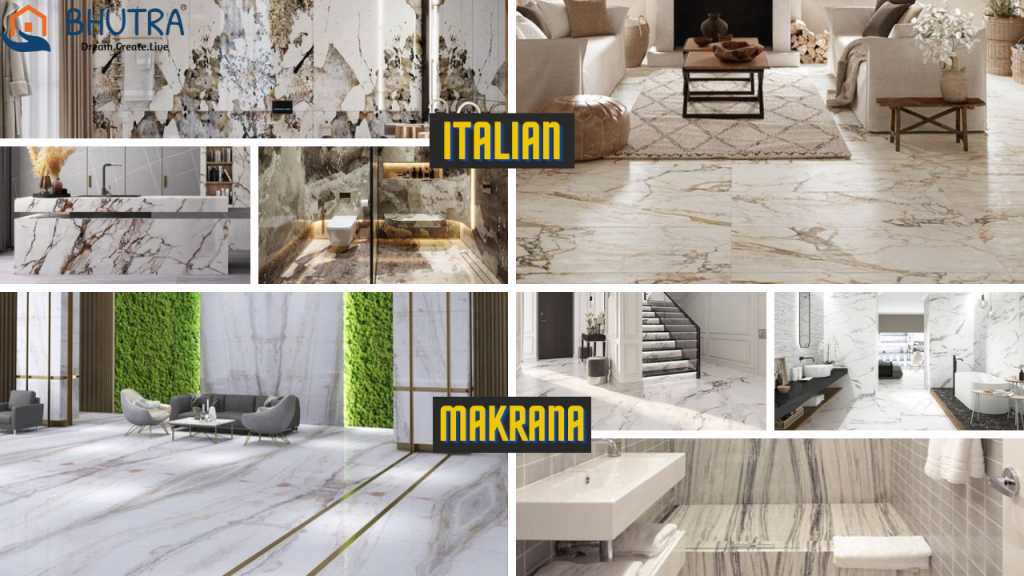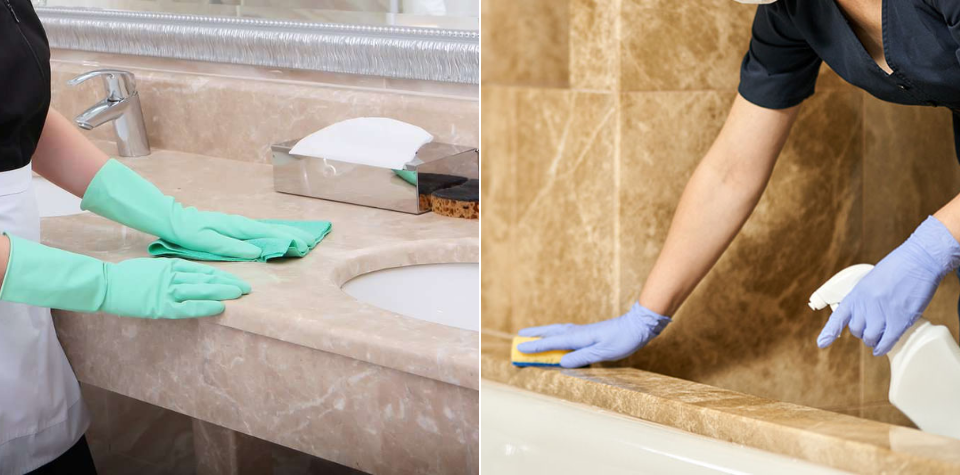Makrana Marble And Italian Marble

How to Check Cracks, Shining, Color, and Patterns of Italian Marble
August 20, 2023
Top 10 Best Marble for Wall Cladding in India
August 26, 2023Marble, with its timeless beauty and elegance, has been a popular choice for interior and exterior decoration for centuries.
Among the numerous varieties available, Makrana and Italian marbles have stood out as two of the most sought-after options.
In this comprehensive comparison, we will delve into the key aspects of both Makrana and Italian marble, helping you make an informed decision for your next design project.
Introduction
Marble has been adorning buildings, sculptures, and interiors for centuries, adding a touch of luxury and grandeur.
Among the diverse options available, Makrana and Italian marble have stood out due to their unique qualities and visual appeal.
In this article, we will undertake a thorough comparison of these marbles to assist you in making an informed choice for your upcoming projects.
Origin and History

| Aspect | Makrana Marble | Italian Marble |
|---|---|---|
| Origin | Rajasthan, India | Various regions in Italy |
| Historical Significance | Used in the construction of the Taj Mahal | Used in ancient Roman sculptures |
Makrana marble hails from the state of Rajasthan in India and holds immense historical significance, having been used in the construction of the iconic Taj Mahal.
On the other hand, Italian marble has a rich legacy dating back to ancient Rome, where it was prominently used in sculpture and architecture.
Composition and Characteristics

| Aspect | Makrana Marble | Italian Marble |
|---|---|---|
| Composition | Predominantly composed of calcite | Varied compositions, including calcite, dolomite, and veining |
| Characteristics | White base, minimal veining | Wide range of colors and veining |
Makrana marble is primarily composed of calcite, resulting in its characteristic white base with minimal veining.
Italian marble, on the other hand, exhibits a diverse composition, including calcite and dolomite, leading to a broader spectrum of colors and intricate veining patterns.
Variety and Colors

| Aspect | Makrana Marble | Italian Marble |
|---|---|---|
| Variety | Limited varieties are available | Extensive range of varieties |
| Colors | Predominantly white | White, beige, gold, gray, and more |
Makrana marble offers limited varieties, mainly focusing on different shades of white. In contrast, Italian marble boasts an extensive range of varieties, showcasing colors such as white, beige, gold, and gray, catering to a wide array of design preferences.
Durability and Strength
| Aspect | Makrana Marble | Italian Marble |
|---|---|---|
| Durability | Moderately durable | Varies based on type and origin |
| Strength | Medium to low | Varies; some types are very strong |
Makrana marble exhibits moderate durability and strength, making it suitable for various indoor applications.
Italian marble’s durability and strength vary based on the specific type and its origin, with certain varieties displaying excellent strength properties.
Finishes and Applications

| Aspect | Makrana Marble | Italian Marble |
|---|---|---|
| Finishes | Polished, honed, and brushed | Polished, honed, leathered, bush-hammered |
| Applications | Flooring, walls, and countertops | Flooring, walls, countertops, and sculptures |
Both Makrana and Italian marbles offer a variety of finishes, including polished and honed. Additionally, Italian marble provides further options like leathered and bush-hammered finishes.
Both marbles find applications in flooring, walls, and countertops, while Italian marble’s versatility extends to sculptures as well.
Maintenance and Care
| Aspect | Makrana Marble | Italian Marble |
|---|---|---|
| Maintenance | Regular sealing required | Regular maintenance needed |
| Care | Susceptible to staining | May require sealing |
Both Makrana and Italian marble require maintenance to preserve their beauty.
Makrana marble is susceptible to staining and needs regular sealing. Italian marble may also require sealing, and both marbles necessitate consistent care to avoid damage and maintain their elegance.
Cost Comparison
| Aspect | Makrana Marble | Italian Marble |
|---|---|---|
| Cost Range | Lower cost | Higher cost |
| Factors | Limited varieties, availability | Wide range of options, rarity |
Makrana marble generally comes at a lower cost compared to Italian marble. This price difference is influenced by factors such as the limited varieties of Makrana marble and its availability, while Italian marble’s higher cost is due to its wide array of options and rarity.
Sustainability Considerations
| Aspect | Makrana Marble | Italian Marble |
|---|---|---|
| Sustainability | Limited sustainable practices | Varies; some quarries adhere to sustainable practices |
Sustainability practices vary among quarries. Makrana marble has faced challenges in terms of sustainable extraction, whereas some Italian marble quarries have taken steps towards more responsible practices. However, sustainability considerations remain important for both options.
Cultural Significance and Popularity
| Aspect | Makrana Marble | Italian Marble |
|---|---|---|
| Cultural Significance | Integral to Indian architecture | Historically significant in Western art and architecture |
| Popularity | Prominent in India | Globally renowned |
Makrana marble holds cultural significance in Indian architecture, while Italian marble has been historically renowned in Western art and architecture.
Both marbles enjoy popularity, with Makrana marble prominently used in India and Italian marble enjoying a global reputation.
Conclusion
In the comparison between Makrana and Italian marble, each option brings its own unique attributes to the table.
Makrana marble, with its historical importance, moderate durability, and affordability, is a choice deeply rooted in Indian architecture.
On the other hand, Italian marble stands out for its wide variety of colors, intricate veining, and global popularity.
Ultimately, the decision between Makrana and Italian marble depends on your project’s requirements, aesthetic preferences, and budget considerations.
Regardless of your choice, both marbles hold a timeless appeal that can elevate the beauty of any space they grace.
FAQs
What sets Makrana Marble apart from others?
Makrana Marble stands out due to its rich heritage, distinctive white color, and subtle veining, evoking a sense of elegance and tradition.
Are Italian Marble countertops suitable for kitchens?
Yes, Italian Marble countertops are suitable for kitchens. However, they require proper sealing and regular maintenance to prevent staining and etching.
How do I maintain the shine of Makrana Marble?
To maintain the shine of Makrana Marble, regularly clean it with a pH-neutral stone cleaner and avoid using abrasive cleaners.
Can I use marble in outdoor spaces?
Marble can be used in outdoor spaces, but factors like climate, maintenance, and slip resistance should be considered when making the choice.
Is the veining pattern in Italian Marble consistent?
No, the veining pattern in Italian Marble varies due to its natural formation. Each slab is a unique piece of art crafted by nature.





 WhatsApp
WhatsApp